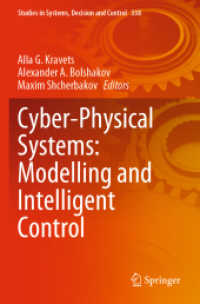Full Description
This is the first comprehensive study of the phenomenon of the armed-struggle revolutionary organisation. The Revolutionary Organisation covers the period from the late 18th century to the present, is global in scope, and discusses organisations inspired by all main ideological traditions: communist, anti-colonialist, nationalist, democratic, Islamist, fascist, and white supremacist. The condition of life-and-death struggle with the state imposes similar patterns of operation upon these organisations, irrespective of their ideological inclinations. This work interprets armed-struggle revolutionary organisations as hybrids of three orientations: an apparatus of professional revolutionaries; an emotional community sustained by ideology, battle comradeship, and ritual; and an instrument of physical force nurturing an heroic organisational ethos.
Contents
Preface and Acknowledgements
Abbreviations
PART 1
Introduction
1 Introduction
1 Revolutionary Organisations
2 Revolution and Modernity
3 Definitions
4 Problems of Definition
5 Three Great Traditions
6 Making Revolution: Spontaneous and Planned Revolutions
7 Methodology
8 Subjectivity, Sources
2 The Revolutionary Organisation
1 Apparatus, Emotional Community, Instrument of Physical Force
2 Apparatus
3 Emotional Community
4 Instrument of Physical Force
5 The Life-and-Death Struggle
PART 2
Professional Revolutionaries
3 Revolutionary Commitment
1 Social Injustice and Humiliation
2 Humiliated Nation. Humiliated Race
3 Gender: Humiliation and the Independent Life
4 Heroes Old and New
5 Heroic Self-Sculpting
6 The Life of Greatness
7 Conversion
8 The Criminal Element
9 Commitment
4 Professional Revolutionaries
1 Revolution as Skill
2 Revolution as Secrecy
3 Revolution on Salary
4 Revolutionary Criminality
5 Bureaucracies in Permanent Crisis: Exiles versus Undergrounders
6 Bureaucracies in Permanent Crisis: the Leader-Centred Organisation
7 Leadership and Gender
5 Revolutionary Intelligentsia, Revolutionary Margin
1 Revolutionary Social Mobility
2 Drifters
3 The Family Uprooted
4 International Armed Solidarity
5 Total Immobility
5.1 Revolutionary Bohemia
6 Communal Living
7 The Mainstream (Or Not-So-Mainstream) Lifestyle
8 The Ascetic-Puritanical Lifestyle
9 The Libertine Lifestyle
6 Emotional Community
1 The Revolutionary Personality
2 Battle
3 The Idea
4 Collective Study
5 Ritual
6 Initiation Ceremonies, the Oath
7 Ceremonies of Periodic Meeting, Martyr Rituals
8 Modes of Address and Dress Codes
9 Revolutionary Symbolism
7 Instrument of Physical Force
1 Warfare and Terrorism
2 Legitimation: Ends and Means
3 A Job to Be Done, Concern, Euphoria, Massacre Fantasies
4 Violence as Purification
5 Revolutionary Heroism, Embedded Heroism
6 Heroic Self-Understanding, Heroic Poetry
7 Heroic Propaganda, Heroic Mobilisation
8 Revolutionary Heroines
9 New Times
PART 3
Apparatus
8 Professional-Revolutionary Philosophies: the Organisation
1 The Pyramid
2 Hierarchy No, Organisation Yes
3 The Pyramid Perfected
4 The Leader
5 From Single Leader to 'Non-Organisation'
6 Emir, Apparatus, Warriors
7 Conclusion
9 The Revolutionary Organisation: Beginnings
1 The Army Problem
2 Bands, Committees, Secret Societies, Religious Congregations
3 Clubs and Parties
4 Volunteer Armies
5 Time of Transition
6 The Rise of the Party in Arms
10 The Politico-Military Organisation
1 Politico-Military Secret Societies
2 Communist Parties in Arms
3 Parties in Arms: Fascism
4 Parties in Arms: Revolutionary Nationalism
5 The Volunteer Army Pyramid
6 Volunteer Army Two-Branchism
7 Islamist Volunteer Armies
8 Committees of Military Officers
9 Terrorist Army Fractions
10 The Politico-Military Control System
11 Military Rebellions
12 Supranational Organisation
11 Revolutionary Etatisation
1 Revolutionary Etatisation: Process
2 Revolutionary Etatisation: Ideology
3 The Nineteenth Century
4 Modes of Etatisation
5 Rural Guerrillas: State Construction
6 Rural Guerrillas: the Social Contract
7 Urban Insurrection
8 Urban Guerrillas
Conclusion: Final Thoughts on Revolutionary Organisation and Violence
1 The Armed-Struggle Ethos
2 Revolution as War
3 The Future of Armed Revolution
Bibliography
Index
Preface and Acknowledgements
Abbreviations
PART 1
Introduction
1 Introduction
1 Revolutionary Organisations
2 Revolution and Modernity
3 Definitions
4 Problems of Definition
5 Three Great Traditions
6 Making Revolution: Spontaneous and Planned Revolutions
7 Methodology
8 Subjectivity, Sources
2 The Revolutionary Organisation
1 Apparatus, Emotional Community, Instrument of Physical Force
2 Apparatus
3 Emotional Community
4 Instrument of Physical Force
5 The Life-and-Death Struggle
PART 2
Professional Revolutionaries
3 Revolutionary Commitment
1 Social Injustice and Humiliation
2 Humiliated Nation. Humiliated Race
3 Gender: Humiliation and the Independent Life
4 Heroes Old and New
5 Heroic Self-Sculpting
6 The Life of Greatness
7 Conversion
8 The Criminal Element
9 Commitment
4 Professional Revolutionaries
1 Revolution as Skill
2 Revolution as Secrecy
3 Revolution on Salary
4 Revolutionary Criminality
5 Bureaucracies in Permanent Crisis: Exiles versus Undergrounders
6 Bureaucracies in Permanent Crisis: the Leader-Centred Organisation
7 Leadership and Gender
5 Revolutionary Intelligentsia, Revolutionary Margin
1 Revolutionary Social Mobility
2 Drifters
3 The Family Uprooted
4 International Armed Solidarity
5 Total Immobility
5.1 Revolutionary Bohemia
6 Communal Living
7 The Mainstream (Or Not-So-Mainstream) Lifestyle
8 The Ascetic-Puritanical Lifestyle
9 The Libertine Lifestyle
6 Emotional Community
1 The Revolutionary Personality
2 Battle
3 The Idea
4 Collective Study
5 Ritual
6 Initiation Ceremonies, the Oath
7 Ceremonies of Periodic Meeting, Martyr Rituals
8 Modes of Address and Dress Codes
9 Revolutionary Symbolism
7 Instrument of Physical Force
1 Warfare and Terrorism
2 Legitimation: Ends and Means
3 A Job to Be Done, Concern, Euphoria, Massacre Fantasies
4 Violence as Purification
5 Revolutionary Heroism, Embedded Heroism
6 Heroic Self-Understanding, Heroic Poetry
7 Heroic Propaganda, Heroic Mobilisation
8 Revolutionary Heroines
9 New Times
PART 3
Apparatus
8 Professional-Revolutionary Philosophies: the Organisation
1 The Pyramid
2 Hierarchy No, Organisation Yes
3 The Pyramid Perfected
4 The Leader
5 From Single Leader to 'Non-Organisation'
6 Emir, Apparatus, Warriors
7 Conclusion
9 The Revolutionary Organisation: Beginnings
1 The Army Problem
2 Bands, Committees, Secret Societies, Religious Congregations
3 Clubs and Parties
4 Volunteer Armies
5 Time of Transition
6 The Rise of the Party in Arms
10 The Politico-Military Organisation
1 Politico-Military Secret Societies
2 Communist Parties in Arms
3 Parties in Arms: Fascism
4 Parties in Arms: Revolutionary Nationalism
5 The Volunteer Army Pyramid
6 Volunteer Army Two-Branchism
7 Islamist Volunteer Armies
8 Committees of Military Officers
9 Terrorist Army Fractions
10 The Politico-Military Control System
11 Military Rebellions
12 Supranational Organisation
11 Revolutionary Etatisation
1 Revolutionary Etatisation: Process
2 Revolutionary Etatisation: Ideology
3 The Nineteenth Century
4 Modes of Etatisation
5 Rural Guerrillas: State Construction
6 Rural Guerrillas: the Social Contract
7 Urban Insurrection
8 Urban Guerrillas
Conclusion: Final Thoughts on Revolutionary Organisation and Violence
1 The Armed-Struggle Ethos
2 Revolution as War
3 The Future of Armed Revolution
Bibliography
Index








